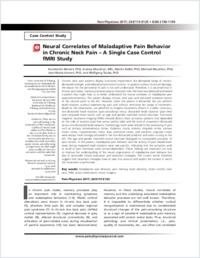Neural correlates of maladaptive pain behavior in chronic neck pain - a single case control fMRI study
- Beinert, Konstantin University of Fribourg, Switzerland and Hochschule für Gesundheitsorientierte Medizin und Bewegungswissenschaft i.Gr, Germany
- Mouthon, Audrey University of Fribourg, Switzerland and Hochschule für Gesundheitsorientierte Medizin und Bewegungswissenschaft i.Gr, Germany
- Keller, Martin University of Fribourg, Switzerland and Hochschule für Gesundheitsorientierte Medizin und Bewegungswissenschaft i.Gr, Germany
- Mouthon, Michaël University of Fribourg, Switzerland and Hochschule für Gesundheitsorientierte Medizin und Bewegungswissenschaft i.Gr, Germany
- Annoni, Jean-Marie University of Fribourg, Switzerland and Hochschule für Gesundheitsorientierte Medizin und Bewegungswissenschaft i.Gr, Germany
- Taube, Wolfgang University of Fribourg, Switzerland and Hochschule für Gesundheitsorientierte Medizin und Bewegungswissenschaft i.Gr, Germany
-
01.02.2017
Published in:
- Pain Physician. - 2017, vol. 20, no. 1, p. E115–E125
English
Chronic neck pain patients display functional impairments like decreased range of motion, decreased strength, and reduced sensorimotor function. In patients without structural damage, the reason for the persistence of pain is not well understood. Therefore, it is assumed that in chronic pain states, memory processes play an important role. We have now detected and tested a patient that might help us to better understand the neural correlates of maladaptive pain expectation/memory. This patient displays chronic neck pain and restricted unilateral motion of the cervical spine to the left. However, when the patient is distracted, she can perform head rotations without experiencing pain and without restricting her range of movement. Based on this observation, we asked her to imagine movements shown in a video: conscious, non- distracted head rotations (pain-provoking) versus distracted head rotations (pain-free) and compared these results with an age and gender matched control volunteer. Functional magnetic resonance imaging (fMRI) showed distinct brain activation patterns that depended on the side of rotation (pain-free versus painful side) and the kind of movement (distracted versus non-distracted head rotation). Interestingly, brain areas related to the processing of pain such as primary somatosensory cortex, thalamus, insula, anterior cingulate cortex, primary motor cortex, supplementary motor area, prefrontal cortex, and posterior cingulate cortex were always more strongly activated in the non-distracted condition and when turning to the left. The age and gender matched control volunteer displayed no comparable activation of pain centers. In the patient, maladaptive pain behavior and the activity of pain-related brain areas during imagined head rotations were task-specific, indicating that the activation and/or recall of pain memories were context-dependent. These findings are important not only to improve the understanding of the neural organization of maladaptive pain behavior but also to reconsider clinical evaluation and treatment strategies. The current results therefore suggest that treatment strategies have to take into account and exploit the context in which the movement is performed.
- Faculty
- Faculté des sciences et de médecine
- Department
- Médecine 3ème année, Département de Médecine
- Language
-
- English
- Classification
- Biological sciences
- Other electronic version
- License
-
License undefined
- Identifiers
-
- RERO DOC 287923
- Persistent URL
- https://folia.unifr.ch/unifr/documents/305325
Statistics
Document views: 149
File downloads:
- pdf: 188
